Achtung Panzer! Skirmish level tank battles
Images courtesy of Warlord Games
Warlord is doing it again!
What are they doing?
Creating another game that expands into an underserved niche. If you feel the need to run some tank on tank combat in 28mm without all that pesky infantry bogging you down, Achtung Panzer! could be the game for you.
But we have a ton of WW2 games now!
I hear you. Warlord’s flagship is Bolt Action, WW2 level Skirmish platoon level combat on the tabletop. There’s also Flames of War in 15mm at the Company level. Not to mention the Too Fat Lardies range of WWII games, and countless others available via sites such at Wargame Vault.
Warlord even has their Tank Wars variant rules for Bolt action.
But this is not Bolt Action rehashed.
So, what makes Achtung Panzer! different?
First, if you play Bolt Action, you’ve probably got a collection of tanks, tank destroyers, and other armored fighting vehicles from the period. Anyone who has spent time playing Bolt Action (BA) in a competitive (eg. tourney) environment learns that BA is geared more towards a Dakka Stuart tank, festooned with infantry killing MGs, than to Panthers and Tigers and Jumbos.
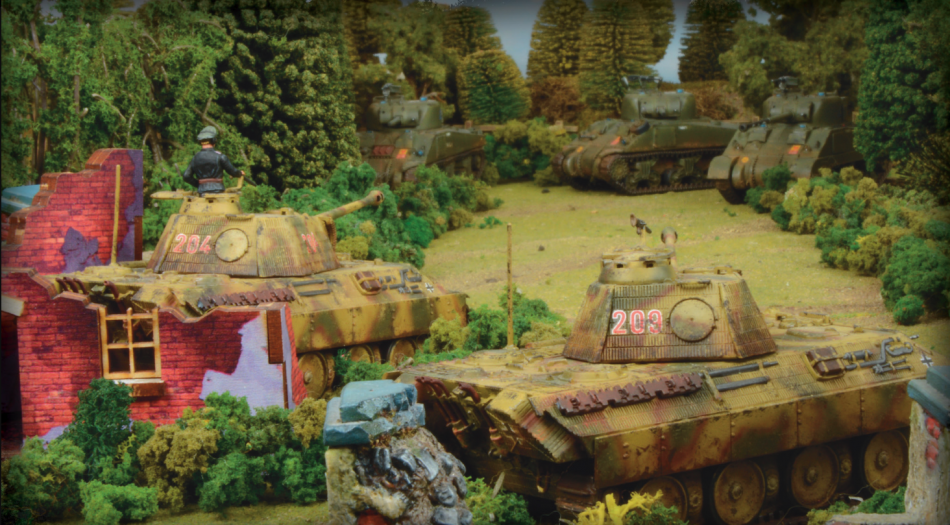
But many players purchase a Tiger or King Tiger model as the “iconic” tank of the period – or whichever BIG tank fits their chosen force. Only to discover that the points for it are out of whack with their local competitive meta.
I’ve got a Panther and a STuG that have been languishing in the pile of gray shame for several years. I purchased both of these prior to the pandemic. Because of Achtung Panzer! I finally have a reason to build them.
Warlord has published a couple of sneak peeks into the game available on their blog, and more will surely have more. Check out the latest posts (as of time of writing) on their blog here, and on movement here.
Game Basics
The game allows measuring at any time, and uses “true line of sight” (more on that later). LOS is always figured from the commander’s cupola on the turret or vehicle top. (Note: I’ll use “Tanks” in the story, but I mean any AFV in the game.)
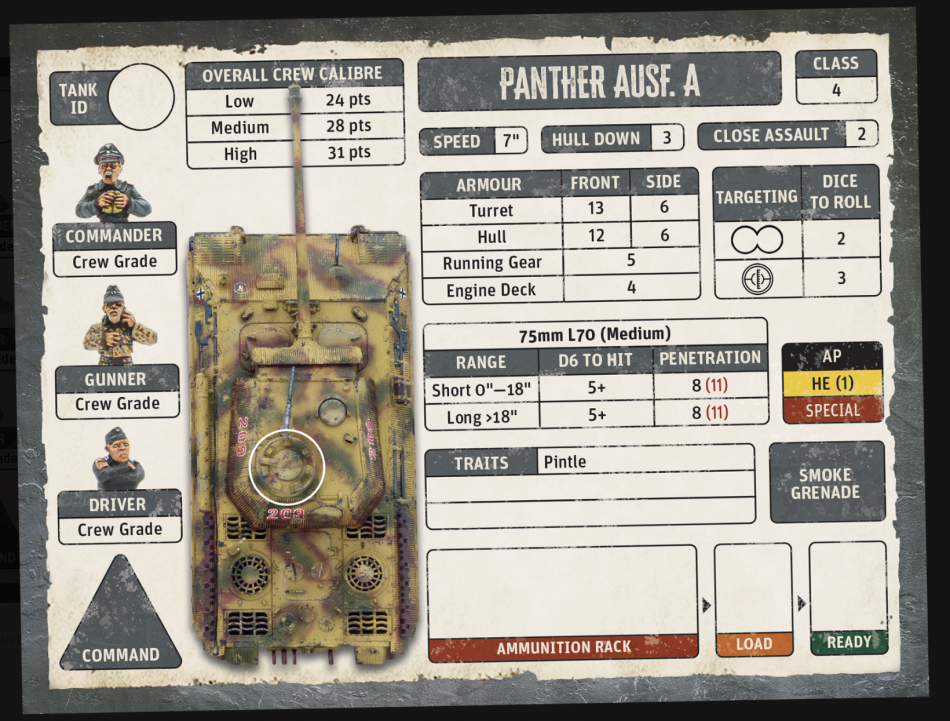
Activation is random, but you won’t need Bolt Action’s order dice to achieve this. Don’t throw out your dice bags, though. You’ll find numbered activation chits in the token set that comes in the starter set (or with the stand alone rule book starter sets).
Players draw numbered chits from a bag, and vehicles activate in numbered order. One goes first, two activates after one, etc.
The player makes a Radio Check at the beginning of their turn. If the radio check is passed, then a player draws one random chit for each tank, and can place them amongst his vehicles in any order. If the Radio Check is failed, then the player nominates a vehicle before each chit is drawn. That chit applies to that vehicle. Yes, the Soviet force has the worst Radio Checks in the game, since many of their platoons relied on flag signals instead of radios.
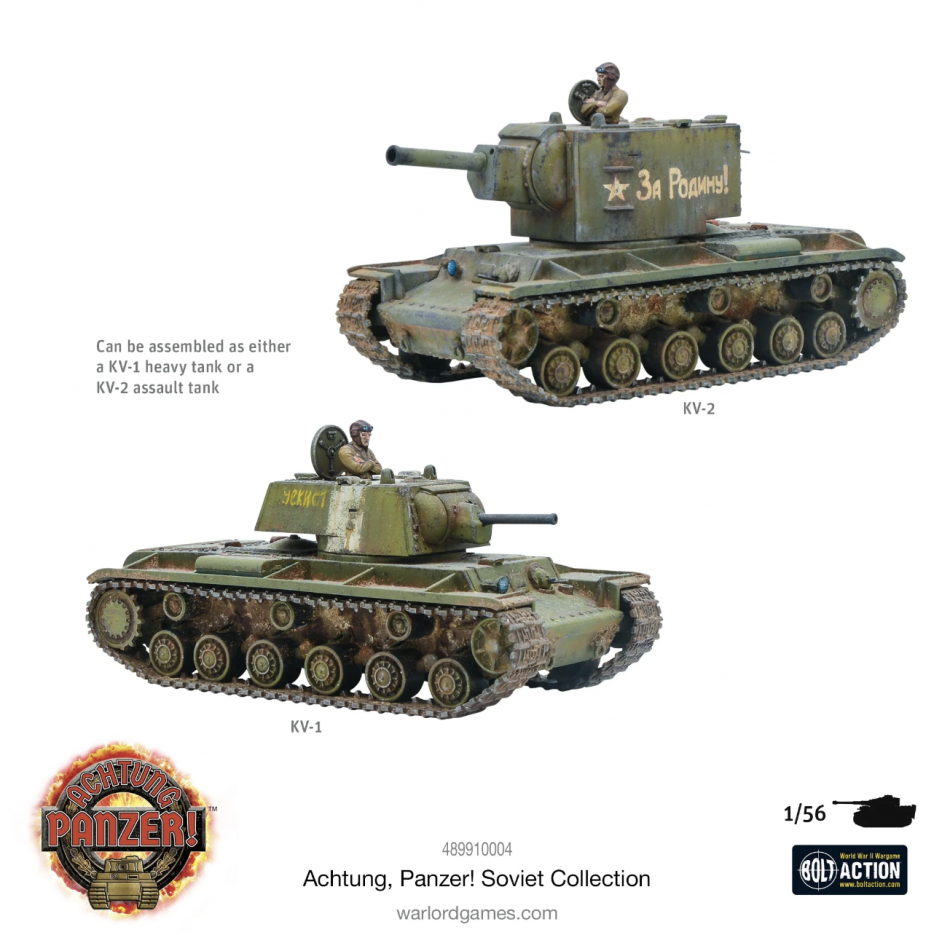
Crew
Part of setting up your platoon is determining the experience grade of each crew member in each tank. Commander, Gunner, and Driver all have ratings that you can mix and match between Green, Trained, and Veteran. Crew checks are made with appropriate skill ranking. Loading test would be with the Gunner’s rating, while spotting is by the Commander’s rating. There are even option rules for Ace ratings for your commander.
Action!
Each game turn includes three Action Phases. Each operable vehicle will get three chances to do stuff in one game turn.
Further, each tank gets a Move Order (Halt, forward, reverse, turn left, turn right). These are decided at the beginning of the phase. Once each tank has its initiative chit, and its move order placed face down, the initiative chits are revealed en-mass to begin the activation phases.
The tank executes both a move and a tactical action in any order in each of its Action Phases. And the end of the third round of action phases, the turn advances.

Orders
Tactical Orders include a free Scoot action directly forward or reverse. This introduces a High/Low die roll. This is done using 2d6. If you’re scooting your tank forward, take the highest of the two numbers. If your tank is scooting in reverse, take the lowest of the two dice as your distance moved. This same High/Low roll is used in several other game mechanics.
Other tactical orders include loading and unloading tank’s weapons, spotting, aiming and firing weapons. As well as pivoting the tank.

The mechanism for a pivot is interesting. This is not a full 90 degree turn, but more of realignment of the front end. The tank pivots from the back, by placing a marker (a finger works well) just in front of one of the tanks’s tracks. Pivot the tank with the rear as the pivot point, so the OTHER track does not go past the marker/finger from the first track’s starting point. This is a simple realignment of the facing without executing much of a turn.
Turretless vehicles (such as a STuG) get extra opportunities to make a pivot to align their man guns, since they don’t get to rotate their turret the same way a tank does..
Right and left turns up to 90 degrees are done via move orders.
Ready rounds
Loading a weapon is a mutli-stage process in Achtung Panzer! Most tanks have HE rounds as well as AP rounds. Tanks with main guns have an ammunition rack noted on their card. With a Tactical order, a crew slides the appropriate ammo marker (HE, AP, Special) one slot to the right. For light guns, that means the gun is now READY to fire. Medium and Large guns have a Loading phase they must go through. The marker goes first to LOAD. Another Tactical Order is needed to move it to READY.
A gunnery crew check can be made to Force Load the main gun, and get the gun loaded in one order. Failure results vary based on type of gun. Medium guns at least move the round into the Load slot, but not the Ready slot. A failure with a Large gun leaves the round in the Ammo Rack.
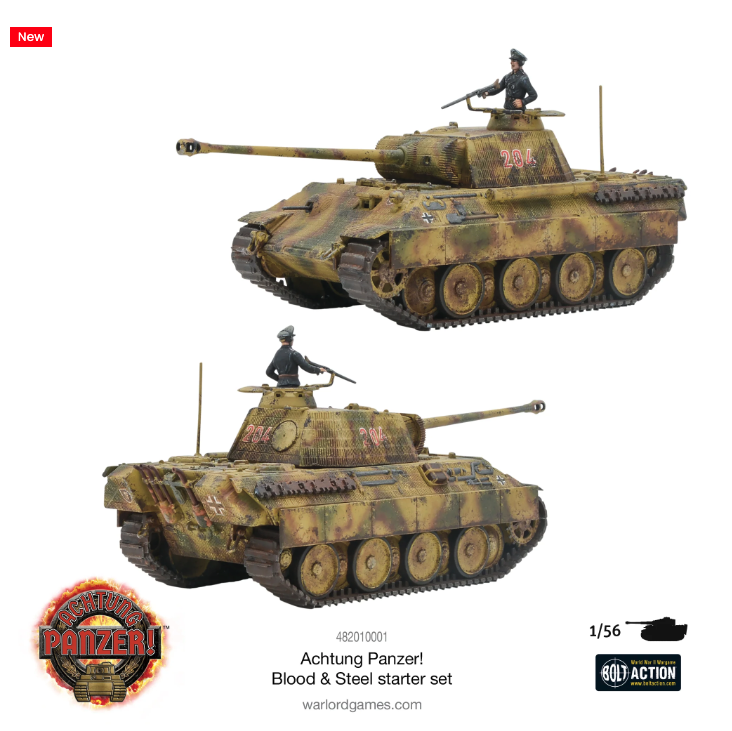
Aim, Fire!
Aiming and firing is a three stage affair as well. First the target must be spotted. This is easier if the tank’s commander has his hatch open and is in “unbuttoned” mode. A successful Spot check can be turned into an Aim with another Tactical Order. Once Aimed, another Tactical order will allow the main gun to fire – but only if the Commander can see the hull of the target.
Spotting and aiming can be made using just the enemy’s gun barrel. Firing at the weapon, though, needs to have some part of the hull visible. I can foresee a need to do some scooting or movement to get tanks into firing position around intervening terrain. But, be careful that your tank commander doesn’t reveal his own side armor to an enemy shot.
Hits and Destruction
Each tank card lists what number it needs to roll on a d6 to hit at either long or short range. Most AT guns hit on a 5+. A few guns have a long range penalty requiring a hit on a 6.
Each type of main gun has a number of d6 to roll when firing. For the Panther, if it has a Halt order, the player rolls 3d6. Each die is treated as a separate attempt. Since the value needed for the Panther to hit is normally a 5+, any die scoring makes the shot a hit.

Modifiers, other than long range, decrease the number of d6s rolled to hit. For example, a Panther that execute a move order (other than Halt) and fires in the same action phase, would roll 2d6 not 3d6. A veteran status gunner on the tank’s crew allows the player to re-roll any 1s on the dice. You only need one die to score a hit. Extra “hits” in the same roll do not give extra benefits.
Successful hits are randomized between turret, hull, and running gear as appropriate to the shooting and terrain conditions. Players may also target a specific portion or the target (Hull, Turret, Running gear), with an appropriate crew check.
Shots have both a hit, and a penetration roll. Penetration rolls that fall short of the armor value do not cause damage. Those that equal the armor value, cause a damage chit to be applied. And those that exceed the armor value cause both a damage chit, as well as a chance to penetrate. The more a penetration roll exceeds an armor value by, the greater the chance of taking out the tank with the shot.
Destroying a tank happens in one of several ways. Either it acquires two successful damage chits to either the hull, or to the turret. Or it acquires three total damage chits (including those to the running gear). Two Running Gear damage chits means the tank is crippled, and cannot move.
In the Cards

There are two types of cards included with the starter box. Event cards are drawn in the administrative step of each turn. They may be played at various times throughout a turn (card specific timing), and they may affect your own force, affect the enemy, or affect the battle. There is even a card that can be played to negate a card played by your opponent.
Overall, these look to add a fun aspect to the game, since, as the book reiterates, no plan survives contact with the enemy.
The other type of card is the force’s asset cards. These cards give a player the opportunity to bring along the ground pounders, the poor bloody infantry, the off-board AT guns, and even an air strike. You don’t need miniatures to represent these. They come along as the card is played, do their dirty deeds, then leave.
Some of these cards, such as Tank Hunters, or Close Assault, work in conjunction with terrain features. Prior to the game, players agree on which terrain features might be ambush territory. These are marked as such. Tanks can clear such potential zones by closing with them and using it’s close assault fire or flame throwers (as appropriate to the vehicle). Or it can stay back and fire an HE shell into the terrain. This flips the marker from potential assault to Cleared.
Of course, if your tank gets within 6” of the terrain, and you have a tank hunters card ready to play, go for it!
These asset cards are “purchased” at the beginning of the game, then stay waiting until you get a Reinforcements, or Extra Reinforcements event card. Playing the Reinforcements card allows you to mobilize the asset card and bring it into a ready state. Then, when conditions are right, you can spring the mobilized asset on your opponent.
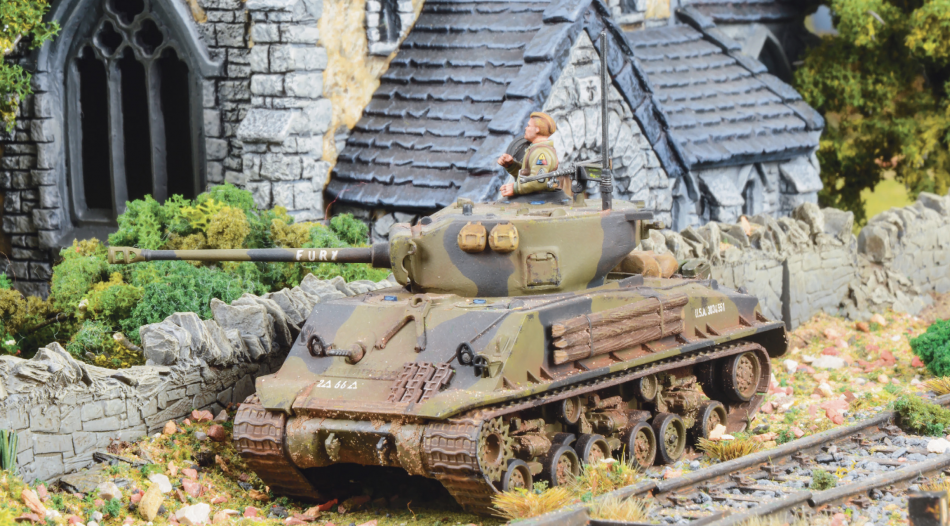
Extras
There are also rules for Tank Aces to include in your force, as well as campaign rules. The book includes six missions to play.
Overall Impressions
Achtung Panzer! looks to be another good addition to the line up of WW2 games. I see potential for event/tourney play, without being as meta-heavy as normal tournament games. The campaign section suggests 75 points for a starting force as a good option. This should give players a range of three to five tanks with a variety of crew skill.
A few caveats for tourney play would need to be made, since crew ratings in each tank are based on points spent. That Crew Calibre rating then allows a player to roll to get a number of “stars” to assign to crew members of that tank (stars equal crew skill ranking). For tourney play, I’d suggest that TOs skip the randomness of the roll, and dictate that crews count as rolling a (for example) a 5 on the chart to equalize the options available to players.
The one area that I see a need for some errata or clarification will be around the use of woods or forest zones.
Because the game uses “true line of sight” and most gamers use a “template” of felt or flocked/painted MDF to represent the footprint of a forest, with moveable trees thereon, how do those two mesh? A ruling of Woods block line of sight, unless all players agree otherwise. Since there is no cover modifier in the game beyond “hull down” or “Prepared Positions”, a woods area needs to be clarified. Be prepared to have this discussion with your opponent before the game begins.
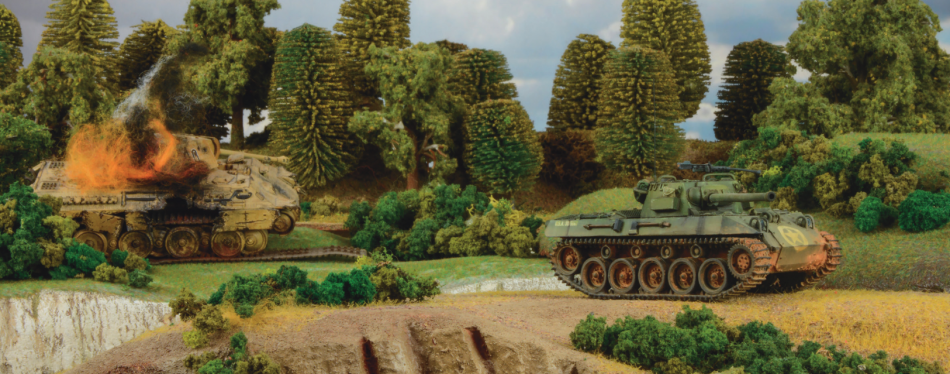
For those who have read my more recent pieces here on NDNG, you might remember that I’ve been going through a bout of hobby burnout. Seeing this game pop up in my social media feeds, and finally getting my eyeballs on an sneak peek of the book helped me climb out of the burnout. I’m not ready to hit all the games, but this one has me painting models again.
Note, I do serve as a Raider for the North American Demo Team, and was given early access. When Jon Russell of Warlord called on Friday with the go-ahead to publish and start demos of the game, I felt some more of that burnout drain away.
I’ve already arranged a demo with my local group for this coming weekend. If all goes well, expect to see a battle report next week. Since the clearance to share info has been given, you can expect to see other Raiders out and about with their tanks, ready to demo. I hope to get to DayCon in Dayton OH (April 12, 13) with this game for at least one slot of demos.
As I mentioned above, I’ve broken the Panther and STuG out of mothballs and will be painting those up in the near future. I think I’ve got a Hetzer hetzing somewhere in my pile of partially painted armor.
I see a few tank battles in my immediate future.

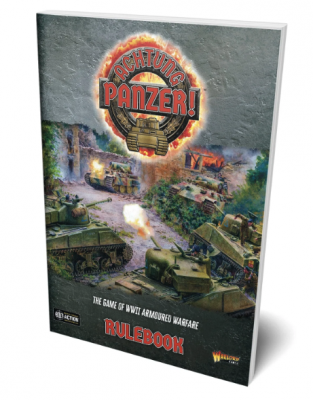
Solid write up THANX Troy!